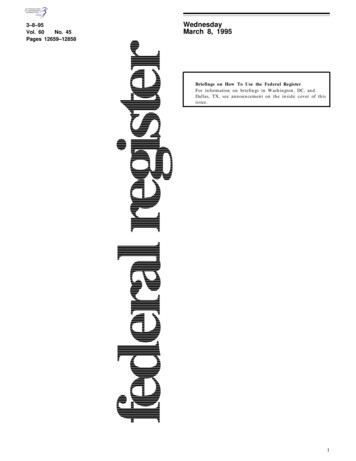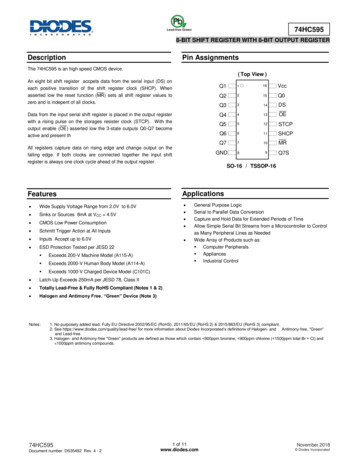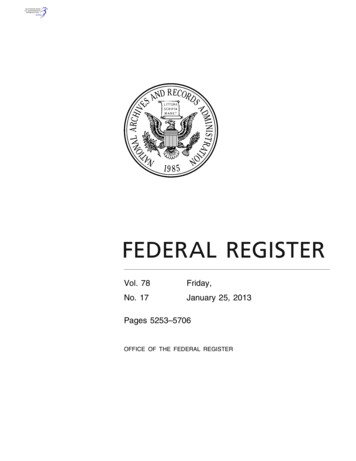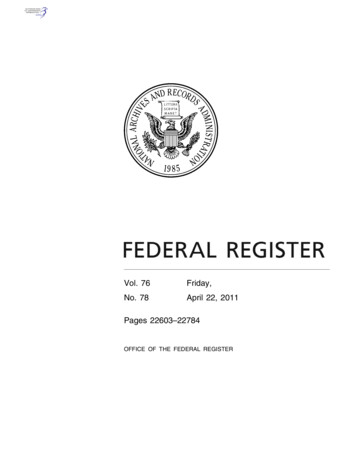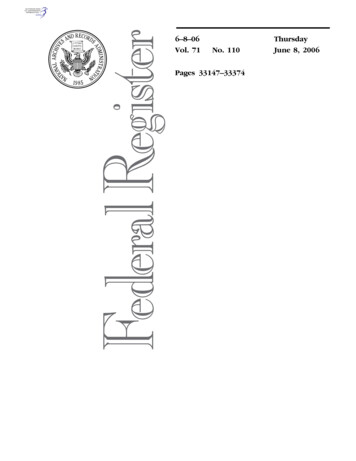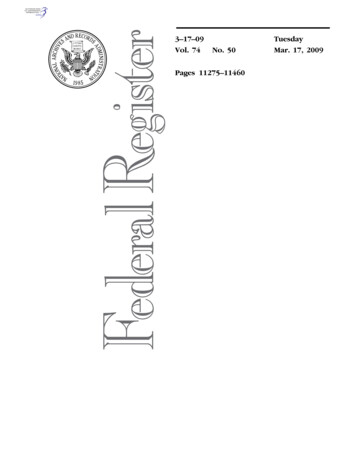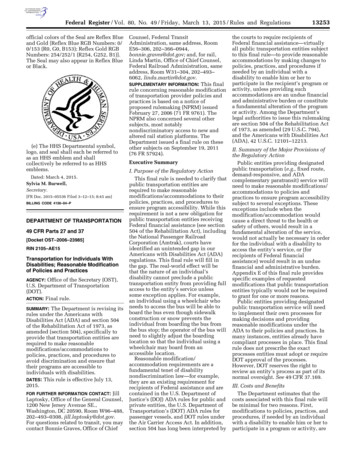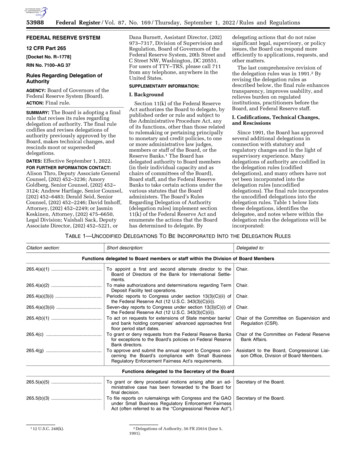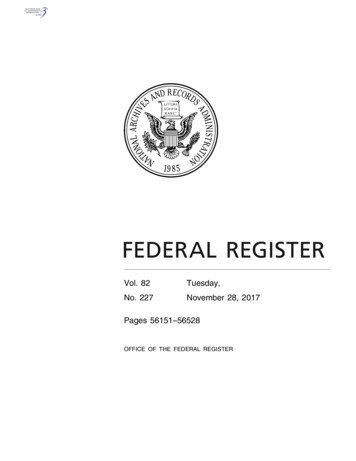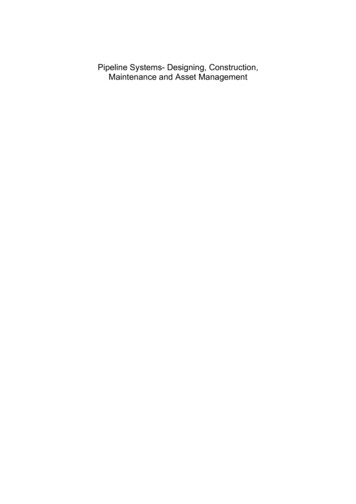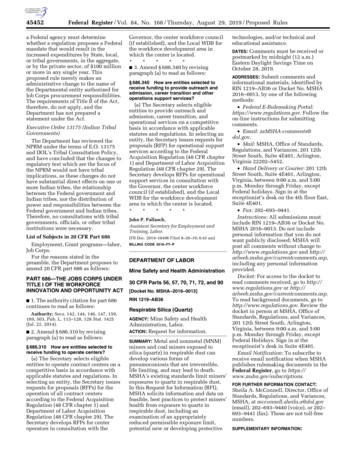
Transcription
45452Federal Register / Vol. 84, No. 168 / Thursday, August 29, 2019 / Proposed Rulesa Federal agency must determinewhether a regulation proposes a Federalmandate that would result in theincreased expenditures by State, local,or tribal governments, in the aggregate,or by the private sector, of 100 millionor more in any single year. Thisproposed rule merely makes anadministrative change to the name ofthe Departmental entity authorized forJob Corps procurement responsibilities.The requirements of Title II of the Act,therefore, do not apply, and theDepartment has not prepared astatement under the Act.Executive Order 13175 (Indian TribalGovernments)The Department has reviewed theNPRM under the terms of E.O. 13175and DOL’s Tribal Consultation Policy,and have concluded that the changes toregulatory text which are the focus ofthe NPRM would not have tribalimplications, as these changes do nothave substantial direct effects on one ormore Indian tribes, the relationshipbetween the Federal government andIndian tribes, nor the distribution ofpower and responsibilities between theFederal government and Indian tribes.Therefore, no consultations with tribalgovernments, officials, or other tribalinstitutions were necessary.List of Subjects in 20 CFR Part 686Employment, Grant programs—labor,Job Corps.For the reasons stated in thepreamble, the Department proposes toamend 20 CFR part 686 as follows:PART 686—THE JOBS CORPS UNDERTITLE I OF THE WORKFORCEINNOVATION AND OPPORTUNITY ACT[FR Doc. 2019–18496 Filed 8–28–19; 8:45 am]BILLING CODE 4510–FT–PDEPARTMENT OF LABORMine Safety and Health Administration30 CFR Parts 56, 57, 70, 71, 72, and 90[Docket No. MSHA–2016–0013]Mine Safety and HealthAdministration, Labor.ACTION: Request for information.2. Amend § 686.310 by revisingparagraph (a) to read as follows:Metal and nonmetal (MNM)miners and coal miners exposed tosilica (quartz) in respirable dust candevelop various forms ofpneumoconiosis that are irreversible,life limiting, and may lead to death.MSHA’s existing standards limit miners’exposures to quartz in respirable dust.In this Request for Information (RFI),MSHA solicits information and data onfeasible, best practices to protect miners’health from exposure to quartz inrespirable dust, including anexamination of an appropriatelyreduced permissible exposure limit,potential new or developing protectiveSUMMARY:§ 686.310 How are entities selected toreceive funding to operate centers?khammond on DSKBBV9HB2PROD with PROPOSALSJohn P. Pallasch,Assistant Secretary for Employment andTraining, Labor.AGENCY: (a) The Secretary selects eligibleentities to operate contract centers on acompetitive basis in accordance withapplicable statutes and regulations. Inselecting an entity, the Secretary issuesrequests for proposals (RFPs) for theoperation of all contract centersaccording to the Federal AcquisitionRegulation (48 CFR chapter 1) andDepartment of Labor AcquisitionRegulation (48 CFR chapter 29). TheSecretary develops RFPs for centeroperators in consultation with theJkt 247001(a) The Secretary selects eligibleentities to provide outreach andadmission, career transition, andoperational services on a competitivebasis in accordance with applicablestatutes and regulations. In selecting anentity, the Secretary issues requests forproposals (RFP) for operational supportservices according to the FederalAcquisition Regulation (48 CFR chapter1) and Department of Labor AcquisitionRegulation (48 CFR chapter 29). TheSecretary develops RFPs for operationalsupport services in consultation withthe Governor, the center workforcecouncil (if established), and the LocalWDB for the workforce developmentarea in which the center is located.*****Respirable Silica (Quartz)Authority: Secs. 142, 144, 146, 147, 159,189, 503, Pub. L. 113–128, 128 Stat. 1425(Jul. 22, 2014).15:50 Aug 28, 2019§ 686.340 How are entities selected toreceive funding to provide outreach andadmission, career transition and otheroperations support services?RIN 1219–AB361. The authority citation for part 686continues to read as follows: VerDate Sep 11 2014Governor, the center workforce council(if established), and the Local WDB forthe workforce development area inwhich the center is located.***** 3. Amend § 686.340 by revisingparagraph (a) to read as follows:PO 00000Frm 00014Fmt 4702Sfmt 4702technologies, and/or technical andeducational assistance.Comments must be received orpostmarked by midnight (12 a.m.)Eastern Daylight Savings Time onOctober 28, 2019.DATES:Submit comments andinformational materials, identified byRIN 1219–AB36 or Docket No. MSHA2016–0013, by one of the followingmethods: Federal E-Rulemaking Portal:https://www.regulations.gov. Follow theon-line instructions for submittingcomments. Email: zzMSHA-comments@dol.gov. Mail: MSHA, Office of Standards,Regulations, and Variances, 201 12thStreet South, Suite 4E401, Arlington,Virginia 22202–5452. Hand Delivery or Courier: 201 12thStreet South, Suite 4E401, Arlington,Virginia, between 9:00 a.m. and 5:00p.m. Monday through Friday, exceptFederal holidays. Sign in at thereceptionist’s desk on the 4th floor East,Suite 4E401. Fax: 202–693–9441.Instructions: All submissions mustinclude RIN 1219–AB36 or Docket No.MSHA 2016–0013. Do not includepersonal information that you do notwant publicly disclosed; MSHA willpost all comments without change tohttp://www.regulations.gov and ng any personal informationprovided.Docket: For access to the docket toread comments received, go to http://www.regulations.gov or http://arlweb.msha.gov/currentcomments.asp.To read background documents, go tohttp://www.regulations.gov. Review thedocket in person at MSHA, Office ofStandards, Regulations, and Variances,201 12th Street South, Arlington,Virginia, between 9:00 a.m. and 5:00p.m. Monday through Friday, exceptFederal Holidays. Sign in at thereceptionist’s desk in Suite 4E401.Email Notification: To subscribe toreceive email notification when MSHApublishes rulemaking documents in theFederal Register, go to https://www.msha.gov/subscriptions.ADDRESSES:FOR FURTHER INFORMATION CONTACT:Sheila A. McConnell, Director, Office ofStandards, Regulations, and Variances,MSHA, at mcconnell.sheila.a@dol.gov(email), 202–693–9440 (voice), or 202–693–9441 (fax). These are not toll-freenumbers.SUPPLEMENTARY INFORMATION:E:\FR\FM\29AUP1.SGM29AUP1
Federal Register / Vol. 84, No. 168 / Thursday, August 29, 2019 / Proposed RulesI. Backgroundkhammond on DSKBBV9HB2PROD with PROPOSALSA. Crystalline Silica Sources, AdverseHealth Effects, and Existing Standardsin Metal and Nonmetal (MNM) and CoalMiningCrystalline silica refers to a chemicalcompound, silicon dioxide (SiO2), thatis most commonly found in nature asquartz but sometimes occurs ascristobalite or, rarely, as tridymite.Quartz accounts for the overwhelmingmajority of naturally occurringcrystalline silica and is present invarying amounts in almost every type ofmineral. Quartz is found in rocks suchas granite, sandstone, limestone, andshale. Mining, milling, and processingcrystalline silica-containing substancescan create airborne respirable particles.Some activities generate more respirabledust than others including, but notlimited to, cutting, sanding, drilling,crushing, grinding, milling, sawing,scraping, jack hammering, excavating,or disturbing materials that containquartz.Mechanized operations can generatelarge amounts of dust, potentiallyexposing miners to elevated levels ofairborne dust, including quartz.1Particles with an aerodynamic diametersmaller than 10 micrometer (mm) aremore likely to be respirable, and asparticle diameter decreases, theproportion of particles that can reachthe lungs’ alveolar region increases.Quartz particles that are small enough toreach the alveolar spaces (respirableparticles) may be deposited and retainedthere, leading to disease development.The amount of time for a miner todevelop lung disease such as chronicobstructive pulmonary disease (COPD)or various forms of pneumoconiosissuch as silicosis, coal workers’pneumoconiosis (CWP), progressivemassive fibrosis (PMF), and rapidlyprogressive pneumoconiosis (RPP)depends on various factors such ascumulative dust exposure and geneticpredisposition to lung damage.2 3 The1 National Institute for Occupational Safety andHealth (NIOSH). 2019. Dust control handbook forindustrial minerals mining and processing. Secondedition. By Cecala AB, O’Brien AD, Schall J, ColinetJF, Franta RJ, Schultz MJ, Haas EJ, Robinson J, PattsJ, Holen BM, Stein R, Weber J, Strebel M, WilsonL, and Ellis M. Pittsburgh PA: U.S. Department ofHealth and Human Services, Centers for DiseaseControl and Prevention, National Institute forOccupational Safety and Health, DHHS (NIOSH)Publication No. 2019–124, RI 9701. https://doi.org/10.26616/NIOSHPUB2019124.2 Blanc P. and A. Seaton. 2016. EditorialPneumoconiosis Redux—Coal Workers’Pneumoconiosis and Silicosis Are Still a Problem.Am J Respir Crit Care Med. 193(6): 603–604.3 Cohen, R. 2015. Clarifying Distribution, Trends,and Determinants of Adverse Health in UnitedStates Miners: Exploration and Integration ofVerDate Sep 11 201415:50 Aug 28, 2019Jkt 247001MNM mining industry includes manycommodities that contain variouspercentages of quartz. MNM miners’exposure to quartz dust depends, inpart, on the type of rock or mineralbeing mined or processed. Eachcommodity, however, has common dustsources related to the mining process,which includes drilling, blasting,loading, hauling, and crushing. MSHAregulates MNM miners’ exposure torespirable dust containing quartz under30 CFR 56.5001 for surface miningoperations and under 30 CFR 57.5001for underground mining operations.MSHA’s existing standard is based onthe American Conference ofGovernmental Industrial Hygienists(ACGIH) Threshold Limit Value (TLV) published in 1973 4 that wasincorporated by reference by MSHA’spredecessor agency, the MineEnforcement Safety Administration(MESA) in 1974 5 and then recodified byMSHA in 1985.6 MSHA’s existingstandard for MNM mines is 10 mg/m3/(percent respirable quartz 2) expressedas the concentration of respirable dustfor a full shift or an 8-hour equivalenttime-weighted average (TWA).7Coal miners are exposed to quartzduring the extraction and processing ofcoal. Exposure to quartz duringextraction occurs when miners disturbthe rock above, below, or within thecoal seam. Exposure also occurs inprocessing plants as the coal is beingsized, crushed, dried, and conveyed.MSHA’s standards (30 CFR 70.101,71.101, and 90.101) limit coal miners’exposure to respirable quartz in relationto the respirable dust standard. Whenrespirable dust samples are analyzed forquartz and the concentration of quartzexceeds 0.1 mg/m3 (100 micrograms percubic meter of air or mg/m3) MRE(British Mining Research Establishment)equivalent concentration, MSHAreduces the applicable respirable duststandard for sections of the mineExisting Data Systems. ALPHA Foundation for theImprovement of Mine Safety and Health—FinalTechnical Report. Grant Number: AFC113–4.University of Illinois at Chicago, School of PublicHealth.4 American Conference of GovernmentalIndustrial Hygienists (ACGIH). 1973. TLVsThreshold Limit Values for Chemical Substances inWorkroom Air Adopted by ACGIH for 1973.Cincinnati, Ohio.5 Mine Enforcement Safety Administration(MESA). 1974. Parts 55/56/57—Health and SafetyStandards—Miscellaneous Amendments. 39 FR24316.6 Mine Safety and Health Administration(MSHA). 1985. Recodification of Safety and HealthStandards for Metal and Nonmetal Mines—FinalRule. 50 FR 4048.7 Example: If the quartz content of the sample is18.0%, the TLV for quartz is: 10 mg/m3/18.0%quartz 2 10 mg/m3/20.0 0.50 mg/m3.PO 00000Frm 00015Fmt 4702Sfmt 470245453represented by the sample data. MSHAcomputes the reduced dust standard bydividing 10 by the percent of quartz (10/percent quartz 8).Since 1974, the National Institute forOccupational Safety and Health(NIOSH) has recommended an exposurelimit for respirable crystalline silica(quartz) of 0.05 mg/m3 (50 mg/m3) ISO.9In 2000, the ACGIH revised itsThreshold Limit Value (TLV ) forrespirable crystalline silica (quartz) to50 mg/m3 (ISO) and has since furtherlowered its TLV to 25 mg/m3 (ISO).10In 2016, the Occupational Safety andHealth Administration (OSHA)amended MSHA’s existing respirablecrystalline silica standards to establish apermissible exposure limit (PEL) of 50mg/m3 (ISO).11B. Existing Controls, IncludingRespiratory ProtectionMSHA requires engineering orenvironmental controls as the primarymeans of controlling respirable dust.This is consistent with section 202(h) ofthe Federal Mine Safety and Health Actof 1977 (Mine Act), which provides thatthe use of respirators shall not besubstituted for environmental controlmeasures in the active workings.Engineering or environmental controlsreduce dust generation by suppressing,diluting, capturing, or diverting the dustbeing generated by the mining process.MSHA addressed the use ofsupplementary means of controllingminers’ exposures to respirable dust inprevious rulemakings. In the preamblesto the 2000 12 and 2003 13 proposedrules 14 on Verification of Underground8 Example: A valid representative dust samplewith an equivalent concentration of 1.12 mg/m3contains 12.3% of quartz dust corresponds to aquartz concentration of 138 mg/m3. The respirabledust standard when quartz is present is maintainedon each shift at or below 0.8 mg/m3 (10/12.3% 0.8 mg/m3).9 National Institute for Occupational Safety andHealth (NIOSH). 1974. Criteria for a recommendedstandard . . . Occupational Exposure to CrystallineSilica. HEW Publication No. (NIOSH) 75–120.10 American Conference of GovernmentalIndustrial Hygienists (ACGIH). 2006. Silica,Crystalline: a-Quartz and cristobalite. Cincinnati,Ohio.11 Occupational Safety and Health Administration(OSHA). 2016. Occupational Exposure to RespirableCrystalline Silica—Final Rule. 81 FR 16286.12 Mine Safety and Health Administration(MSHA). 2000. Verification of Underground CoalMine Operators’ Dust Control Plans andCompliance Sampling for Respirable Dust—Proposed rule; notice of hearings. 65 FR 42122.13 Mine Safety and Health Administration(MSHA). 2003. Verification of Underground CoalMine Operators’ Dust Control Plans andCompliance Sampling for Respirable Dust—Proposed rule; notice of hearings; close of record.68 FR 10784.14 The 2010 proposed rule (75 FR 64413)combined the following rulemaking actions: (1)E:\FR\FM\29AUP1.SGMContinued29AUP1
45454Federal Register / Vol. 84, No. 168 / Thursday, August 29, 2019 / Proposed Ruleskhammond on DSKBBV9HB2PROD with PROPOSALSCoal Mine Operators’ Dust Control Plansand Compliance Sampling forRespirable Dust (Plan Verificationsproposed rules), MSHA discussed apetition for rulemaking to allow the useof powered air purifying respirators(PAPRs) as a supplemental means ofcompliance. In the preamble to the 2000proposed rule, MSHA proposed to‘‘permit, under certain circumstances,the limited use of either approved loosefitting PAPRs or verifiableadministrative controls for compliancepurposes’’ (65 FR 42135). In thepreamble to the 2003 proposed rule,MSHA proposed to ‘‘permit the limiteduse of either approved PAPRs,administrative controls, or acombination of both for compliancepurposes in those circumstances wherefurther reduction of dust levels cannotbe reasonably achieved using all feasibleengineering controls.’’ (68 FR 10800).MSHA explained that there may beonly limited situations where exposurescould not be consistently controlled byavailable technologies (65 FR 42134; 68FR 10798–10799, 10818). MSHAreiterated that engineering orenvironmental controls are the primarymeans to control respirable dust in themine atmosphere, which is consistentwith sections 201(b) and 202(h) of theMine Act. MSHA also noted that theDust Advisory Committee unanimouslyrecommended that respiratoryprotection should not replaceengineering or environmental controls,but should continue to be provided tominers until controls are implementedthat are capable of maintainingrespirable dust levels in compliancewith the standards.15 In those limitedsituations, mine operators are requiredto provide respiratory protection tominers while they adjust engineeringand environmental controls to reducedust levels to at or below the standard.In addition, in MSHA’s 2014rulemaking on Lowering Miners’Exposure to Respirable Coal Mine Dust,including Continuous Personal Dust‘‘Occupational Exposure to Coal Mine Dust(Lowering Exposure);’’ (2) ‘‘Verification ofUnderground Coal Mine Operators’ Dust ControlPlans and Compliance Sampling for RespirableDust’’ (Plan Verification) (65 FR 42122, July 7, 2000,and 68 FR 10784, March 6, 2003); (3)‘‘Determination of Concentration of Respirable CoalMine Dust’’ (Single Sample) (65 FR 42068, July 7,2000, and 68 FR 10940 March 6, 2003); and (4)‘‘Respirable Coal Mine Dust: Continuous PersonalDust Monitor (CPDM)’’ (74 FR 52708, October 14,2009). The 2010 proposed rule was finalized onMay 1, 2014 (84 FR 24814).15 U.S. Department of Labor, Mine Safety andHealth Administration. 1996. Report of theSecretary of Labor’s Advisory Committee on theElimination of Pneumoconiosis Among Coal MineWorkers. Washington, DC. October 1996.VerDate Sep 11 201415:50 Aug 28, 2019Jkt 247001Monitors (Dust Rule),16 commentersadvocated the use of PAPRs, not only asa temporary supplementary control, butalso as an engineering control. Othercommenters stated that using respiratorsas a means of complying with the duststandard is contrary to the Mine Act andwould provide miners with a false senseof protection. Some commenters citedthe difficulty of wearing respirators inhot and sweaty jobs, and in dusty, dirtyconditions, including in low coal. Whilethe final rule allows operators to useengineering and administrative controls,the rule did not contain provisions toallow operators to use respirators,including PAPRs, as supplementarycontrols to achieve compliance with therespirable dust standards. As specifiedin Sections 201(b) and 202(h) of theMine Act and since passage of theFederal Coal Mine Health and SafetyAct of 1969, MSHA has enforced anenvironmental standard at coal mines;that is, the concentration of respirabledust in the mine atmosphere ismeasured rather than the breathing zoneof any individual miner.Engineering controls, also known asenvironmental controls, are the mostprotective means of controlling dustgeneration at the source. MSHA is awarethat there may be conditions whereexisting engineering or environmentalcontrols may not be adequate tocontinuously protect miners’ health inareas where there are high levels ofquartz dust.NIOSH researchers have documentedlarge clusters of coal miners in easternKentucky, West Virginia, and southwestVirginia with PMF, the most severe formof black lung disease.17 18 NIOSHreported that a high proportion of thesecases had r-type opacities, category Band C large opacities, and coal miningtenure of less than 20 years, which areindications of exceptionally severe andrapidly progressive disease. Historically,the typical progression (latency) from anormal chest X-ray to advancedpneumoconiosis in coal miners exposedto coal dust was 15 to 25 years ofworking tenure.19 However, as mininghas become highly mechanized, some16 Mine Safety and Health Administration(MSHA). 2014. Lowering Miners’ Exposure toRespirable Coal Mine Dust, Including ContinuousPersonal Dust Monitors—Final rule. 79 FR 24814.17 Blackley, D., C. Halldin, and A. Laney. 2016.Resurgence of Progressive Massive Fibrosis in CoalMiners—Eastern Kentucky, 2016. Morbidity andMortality Weekly Report, 65 (49):1385–9.18 Blackley, D., L. Reynolds, C. Short, et al. 2018b.Research Letter: Progressive Massive Fibrosis inCoal Miners from 3 Clinics in Virginia. JAMA,319(5):500–1.19 Petsonk, E., C. Rose, and R. Cohen. 2013. CoalMine Dust Lung Disease—New Lessons from an OldExposure. Am J Respir Crit Care Med.,187(11):1178–1185.PO 00000Frm 00016Fmt 4702Sfmt 4702miners may be exposed to higherconcentrations of dusts, includingquartz.20 NIOSH defined rapidprogression of the disease as an increaseof greater than one small ILO(International Labor Organization)category within a period of 5 years, orthe development of PMF.21 22 23Researchers also noted that onepotential cause of a rapidly progressivedisease is overexposure to respirablequartz.24 25 26Recent studies indicate that overexposure to quartz presents same healthrisks to MNM miners.27 28 29 30 Although20 ‘‘Drilling into the typical quartz-containingrock surrounding coal seams (e.g., driving tunnelsto the seam and drilling the roof to bolt supportsto rock above to prevent collapse) long has beenrecognized to cause silicosis. In addition, however,extrusions of quartz into coal seams may occur . . .accelerated silicosis may result from exploitation ofthin seams using coal cutters that take slices of theroof and floor’’ (Blanc and Seaton, 2016, page 604).21 Antao, V.C. dos S., E.L. Petsonk, L.Z. Sokolow,et. al. 2005. Rapidly Progressive Coal Workers’Pneumoconiosis in the United States: GeographicClustering and Other Factors. Occup Environ Med.,62(10):670–674.22 Cohen, R.A., A. Patel, and F.H. Green. 2008.Lung Disease Caused By Exposure to Coal Mine andSilica Dust. Seminars in Respiratory and CriticalCare Medicine, 29(6):651–661. Epub. Feb 16, 2009.23 National Academies of Sciences, Engineering,and Medicine. 2018. Monitoring and SamplingApproaches to Assess Underground Coal Mine DustExposures. Washington, DC: The NationalAcademies Press. doi: dustexposures. Page 16.24 Halldin, C., A. Wolfe, and A. Laney. 2015(b).Debilitating Lung Disease Among Surface CoalMiners With No Underground Mining Tenure.JOEM, 57():62–67.25 Petsonk, E., C. Rose, and R. Cohen. 2013. CoalMine Dust Lung Disease—New Lessons from an OldExposure. Am J Respir Crit Care Med.,187(11):1178–1185.26 Cohen, RA., E. Petsonk, C. Rose, et al. 2016.Lung Pathology in U.S. Coal Workers with RapidlyProgressive Pneumoconiosis Implicates Silica andSilicates. Am J Respir Crit Care Med Vol 193(6):673–680.27 Institute of Occupational Medicine (IOM 2011).Health, socio-economic and environmental aspectsof possible amendments to the EU Directive on theprotection of workers from the risks related toexposure to carcinogens and mutagens at work—Respirable crystalline silica. IOM Research Project:P937/8. May 2011. Edinburgh, UK.28 National Institute for Occupational Safety andHealth (NIOSH). 2019. Dust control handbook forindustrial minerals mining and processing. Secondedition. By Cecala AB, O’Brien AD, Schall J, ColinetJF, Franta RJ, Schultz MJ, Haas EJ, Robinson J, PattsJ, Holen BM, Stein R, Weber J, Strebel M, WilsonL, and Ellis M. Pittsburgh PA: U.S. Department ofHealth and Human Services, Centers for DiseaseControl and Prevention, National Institute forOccupational Safety and Health, DHHS (NIOSH)Publication No. 2019–124, RI 9701. https://doi.org/10.26616/NIOSHPUB2019124.29 Occupational Safety and Health Administration(OSHA). 2016. Occupational Exposure to RespirableCrystalline Silica—Final Rule. 81 FR 16286.30 U.S. Department of Labor (USDOL). 2008. APractical Guide to an Occupational Health Programfor Respirable Crystalline Silica. A Joint Project of:E:\FR\FM\29AUP1.SGM29AUP1
Federal Register / Vol. 84, No. 168 / Thursday, August 29, 2019 / Proposed Ruleskhammond on DSKBBV9HB2PROD with PROPOSALSmost MNM miners with early-stagesilicosis (ILO categories 0/1 or 1/0)typically do not experience respiratorysymptoms, the primary risk to theaffected miner is progression of diseasewith progressive decline of lungfunction. Several studies of MNMminers exposed to respirable crystallinesilica (quartz) have shown that, oncesilicosis is detected by x-ray, asubstantial proportion of affectedminers can progress beyond ILOcategory 1 silicosis, even after exposurehas ceased.31 32 33 34Respiratory protection may play animportant role in reducing miners’exposure to respirable quartz. MSHA’sexisting coal (30 CFR 72.700, 72.701,and 72.710) and MNM standards (30CFR 56/57.5005) require respiratoryprotection to be approved by NIOSHunder 42 CFR part 84 (Approval ofRespiratory Protective Devices), andincorporate by reference the AmericanNational Standards Institute’s (ANSI’s)‘‘Practices for Respiratory ProtectionANSI Z88.2–1969’’ standard.35 MSHA isaware that in 2015, ANSI updated theZ88.2 standard.36 A copy of the 2015ANSI standard is in the docket andMSHA seeks comment on this updatedstandard.Under MSHA’s MNM standards (30CFR 56/57.5005), control of miners’exposure to respirable quartz must,where feasible, be achieved by exhaustventilation, or by dilution withuncontaminated air. However, whereaccepted engineering control measureshave not been developed or whennecessary by the nature of workinvolved, miners may work forreasonable periods of time in a locationwhere concentrations of respirablequartz exceed permissible levels only ifThe Industrial Minerals Association—NorthAmerica and the Mine Safety and HealthAdministration. Instruction Guide Series IG 103.January 25, 2008.31 Hessel, P.A., G.K. Sluis-Cremer, E. Hnizdo; etal. 1988. Progression OF Silicosis in Relation toSilica Dust Exposure. Ann. O. Hyg., 32(Suppl1):689–696.32 Kreiss K. and B. Zhen. 1996. Risk of silicosisin a Colorado mining community. Am J Ind Med.,30(5):529–39.33 Ng T.P., S.L. Chan, and K.P. Lam. 1987a.Radiological progression and lung function insilicosis: A ten year follow up study. Br Med J.,295:164–168.34 Yang, H., L. Yang, J. Zhang, et al. 2006. NaturalCourse of Silicosis in Dust-exposed Workers. J.Huazhong University of Science and Technology,[Med Sci]. 26(2):257–260.35 American National Standards Institute (ANSI).1969. Practices for Respiratory Protection ANSIZ88.2–1969. New York, New York.36 American National Standards Institute (ANSI).American National Standard—Practices forRespiratory Protection—ANSI/ASSE Z88.2–2015.American National Standards Institute, Inc.American Society of Safety Engineers, Park Ridge,Illinois. Approved March 4, 2015.VerDate Sep 11 201415:50 Aug 28, 2019Jkt 247001they are protected by appropriaterespiratory protective equipment.MSHA’s standards for coal dust (30CFR 70.208, 70.209, 71.206, and 90.207)require that either during operatorexposure monitoring when a validrepresentative sample meets or exceedsthe excessive concentration value, orwhen the mine operator receives acitation for a violation of the applicablestandard, the mine operator must takeactions to protect miners, includingmaking respiratory protection availablewhile evaluating and implementing dustcontrol measures, as necessary, toreduce miners’ exposures to respirabledust. Under MSHA’s existing coalstandards, however, miners are notcompelled to wear respirators and mineoperators cannot use respirators as asubstitute for engineering orenvironmental controls. Also MSHAcannot credit mine operators’ use ofrespiratory protection in achievingcompliance.C. Hierarchy of ControlsControlling exposures to occupationalhazards is the primary way to protectworkers. Traditionally, mine operatorsuse a hierarchy of controls to determinehow to implement feasible and effectivecontrol solutions and are consideredgenerally accepted industry hygieneprinciples. The hierarchy of controlsbegins with the most effective controls:Elimination and substitution of hazards.Elimination and substitution of hazards,while most effective at reducing risks,are not feasible to reduce exposures torespirable crystalline quartz for MNM orcoal mining. The controls that arerelevant in mining are: Engineeringcontrols, administrative controls, andpersonal protective equipment (PPE).Engineering controls are favored overadministrative controls and PPE forcontrolling miner exposures in theworkplace because they are designed toremove the hazard at the source, beforeminers are exposed. Well-designed,installed, and maintained engineeringcontrols can be highly effective inprotecting miners and are typicallyindependent of worker interactions(human factors) to provide a high levelof protection.37Administrative controls and PPE arefrequently used with existing workplacepractices where hazards are not wellcontrolled. These methods forprotecting miners have proven to be lesseffective than engineering controls,37 National Institute for Occupational Safety andHealth (NIOSH). 2015. Hierarchy of Controls.NIOSH website at: https://www.cdc.gov/niosh/topics/hierarchy/. Accessed June 4, 2019, lastreviewed January 13, 2015.PO 00000Frm 00017Fmt 4702Sfmt 470245455requiring significant effort by the mineoperator and affected miners.In mining, engineering orenvironmental controls include allmethods that control the level ofrespirable dust by reducing dustgeneration (machine parameters) or bysuppressing (water sprays, wettingagents, foams, water infusion, etc.),diluting (ventilation), capturing dust(dust collectors) or diverting dust(shearer clearer, passive barriers, etc.).Administrative controls refer to workpractices that reduce miners’ dailyexposure to respirable dust hazards byaltering the way in which work isperformed. Administrative controlsconsists of such actions as rotation ofminers to areas having lower dustconcentrations, rescheduling of tasks,and modifying work activities. Theeffectiveness of administrative controlsrequires oversight to ensure that minersadhere to the controls, such asrestrictions of time in an area orswitching duties. Using administrativecontrols also requires a sufficientnumber of qualified miners available toperform the specific duties.A form of PPE, an air purifyingrespirator is designed to protect minersfrom the inhalation of hazardouscontaminants. Respirators can protectminers by removing contaminants fromthe air they breathe. Particulate airpurifying respirators remove or filterairborne contaminants from the airbefore they can be inhaled. Examples ofthis type of respi
the Governor, the center workforce council (if established), and the Local WDB for the workforce development area in which the center is located. * * * * * John P. Pallasch, Assistant Secretary for Employment and Training, Labor. [FR Doc. 2019-18496 Filed 8-28-19; 8:45 am] BILLING CODE 4510-FT-P DEPARTMENT OF LABOR
